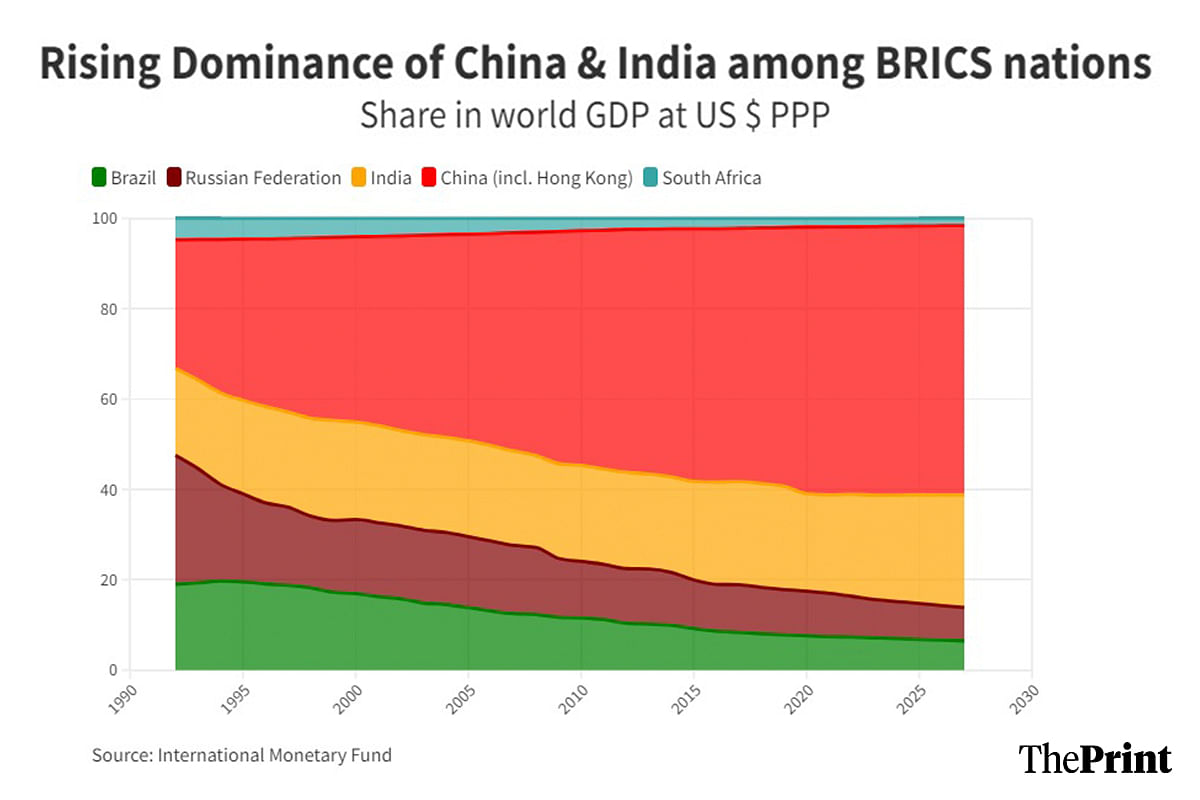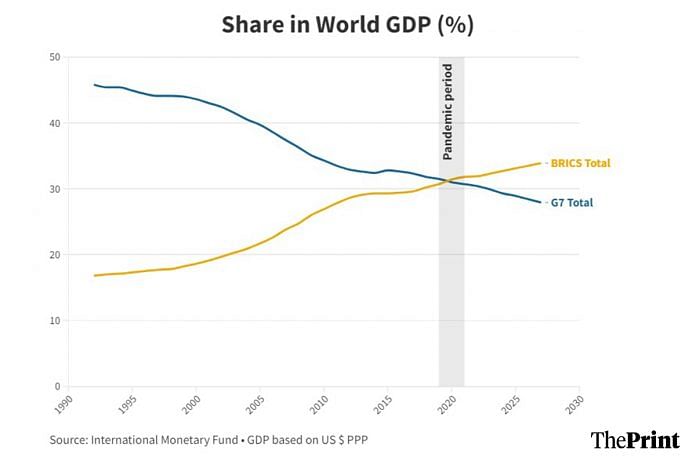New Delhi: The Covid-19 pandemic served as a watershed moment in several ways, including marking the point when the global economic power dynamic changed in favour of developing countries. Data shows that, beginning 2020, the BRICS nations as a whole now contribute more towards global Gross Domestic Product (GDP) than the G7 industrialised nations do, in terms of purchasing power parity (PPP).
The BRICS countries comprise Brazil, Russia, India, China, and South Africa, and represent the largest developing economies. The G7 are the largest industrialised economies and consist of the US, the UK, Germany, France, Japan, Italy, and Canada.
While the G7 countries have historically been among the largest economies in the world, the BRICS nations — especially China and India — have been and continue to be the most populous. The G7 nations account for about 10 per cent of the world’s population, whereas just India and China, with 140-141 crore people each, together make up about 35 per cent.
ThePrint analysed the International Monetary Fund’s (IMF) GDP data across countries over time and found that since 1992, there has been a steady decline in the share of the G7 in global GDP, and an equally steady rise in the contributions of the BRICS nations.
The GDP measures were taken in US dollars at purchasing power parity (PPP), which allows for a comparison across countries. The year 1992 was the first for which there was data for all the countries being considered.
Conventionally, the GDP of a country can be described in several ways, each of which is based on the yardstick used to measure it. Nominal GDP growth measures the value of the goods and services produced by an economy at a given point in time. That is, at ‘current prices’. Real GDP growth looks at the value of GDP on the basis of a ‘constant price’, so that inflation is accounted for.
In order to make cross-country comparisons, it is important to make adjustments based on the currency exchange rates as well. The PPP model does just this. It arrives at a theoretical exchange rate at which you can buy the same amount of goods and services across countries. The value of GDP at PPP is then calculated using this theoretical exchange rate.
By 2019, the contributions of the two groupings had become nearly equal, with the G7 contributing 31.5 per cent to global GDP, and the BRICS accounting for 30.7 per cent.
Within the BRICS, however, the break-up highlights the dominance of China (itself accounting for 17.6 per cent of global GDP in 2019), followed by India at a distant second (7 per cent). Russia (3.1 per cent), Brazil (2.4 per cent), and South Africa (0.6 per cent) together made up just 6.1 per cent of world GDP.
It was in 2020, however, that the G7-BRICS dynamic flipped. That year, the BRICS (31.4 per cent) overtook the G7 (30 per cent).
In other words, 2020 was the year the global economic power dynamic shifted in favour of developing countries, marking a key landmark in the ongoing decline of the developed nations in terms of economic might.
Within that, it also brought to the fore the seemingly inexorable rise of China and, to an extent, India as economic engines for the world.
“The trend of the emerging market economies or Asian economies seeing their shares rising has been a much longer trend, about three-four decades now,” Ajit Ranade, vice-chancellor of the Gokhale Institute of Politics & Economics in Pune and former chief economist of the Aditya Birla Group, told ThePrint, adding: “It is largely driven by China, but also by smaller Asian economies.”
Also Read: India’s GDP to grow at a slower 6% in FY24, inflation to ease to 5% that year: CRISIL
Rise of China & India
“It was inevitable that the BRICS — which is dominated by China and India — would eventually overtake the G7,” Ranade said. However, he believes that this change happening in 2020 was more a coincidence than a consequence of the pandemic.
“During the pandemic, China didn’t suffer as much of a negative shock as other major economies did, so maybe that did contribute to it,” he said. “But it had to happen, and it happened to be 2020 when it did.”
The IMF data makes projections till 2027 as well, and these show the BRICS and the G7 diverging again, but this time with the developing countries extending their lead over the industrialised ones.
The gains on behalf of the developing countries have largely been made by China and India. The data shows that the 2000-10 decade was squarely China’s. During this period, it rapidly caught up with the US in terms of share in world GDP (nearly doubling its contribution to 14 per cent in 2010 from 7.6 per cent in 2010), and by 2013, had overtaken it to become the largest economy in PPP terms.
In nominal terms, however, the US was and still is far ahead. In 2013, the US was a $16.2 trillion economy in current US dollars, while China was at $9 trillion. India was a $1.9 trillion economy at the time.
India’s decade
It is in the third decade of this century (2021-30) that India is predicted to really increase its contribution to world GDP, according to the IMF’s estimates. From contributing 6.7 per cent in 2020, it is predicted to account for 8.5 per cent by 2027, which will likely grow further over the subsequent three years.

The current decade being India’s time to shine has been highlighted by other organisations as well. Morgan Stanley had, in November 2022, released a report titled ‘Why This Is India’s Decade’, in which it said that India was taking the right steps in enhancing investments in manufacturing, the energy transition, and digital infrastructure.
According to Ranade, this rapid growth of countries like China and India is also part of a larger trend and, in part, driven by the relatively low per-capita incomes in these countries.
“One of the side effects of globalisation is a kind of convergence, where countries with lower per-capita incomes grow faster,” Ranade explained. “So eventually, a country’s share in global GDP will start reflecting its share in the global population. Such a thing takes several decades to happen.”
Even among the BRICS nations, the most populous countries are the ones driving the growth, the data shows.
At the moment, India and China together make up nearly 27 per cent of world GDP. By 2027, this is estimated to grow to nearly 29 per cent. That said, even by then, the relationship between the two Asian countries is estimated to remain highly unequal, with China itself contributing more than 20 per cent to world GDP
(Edited by Smriti Sinha)
Also read: How did Indian economy perform during pandemic & after? Turns out, not as badly as was estimated



